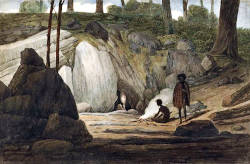6. WELLINGTON CAVES
While not the first limestone caves to be discovered in NSW, they were the first to become well known, largely because of the many fossils which were found in their muddy filling.
 The first reference to caves near Wellington that I have found is this painting by Augustus Earle, made in 1826 and labelled "Mosman's Cave". It definitely shows the entrance to today's "Cathedral Cave".
The first reference to caves near Wellington that I have found is this painting by Augustus Earle, made in 1826 and labelled "Mosman's Cave". It definitely shows the entrance to today's "Cathedral Cave".In May 1830 George Rankin of Bathurst entered the cave. There is a fascinating report in the "Sydney Gazette and New South Wales Advertiser", Tuesday May 22nd 1830. You can download yourself from Trove or perhaps read it here. Sorry about the font size!
There is more to the newspaper report which you will need to locate yourself. More excavations for fossils were carried out through the 19th century and later.
Fossils From the Caves

 A few examples of the tens of thousands of fossils found in the caves. These are in no way related to the fossils found in the limestone which forms the caves.
A few examples of the tens of thousands of fossils found in the caves. These are in no way related to the fossils found in the limestone which forms the caves.The Wellington Caves limestone deposit crops out south of Wellington in the Early Devonian Garra Formation.
The deposit is essentially composed of a succession of limestone and shale beds between 900 and 1200 m thick. The main deposit of limestone crops out close to the Wellington - Molong road and extends more or less continuously as a prominent ridge for a distance of approximately 3 km. It disappears northward under the alluvium of the Bell River.
It is typically a light grey colour, but a variety of colours are to be found. The texture is compact to finely crystalline and fossil corals are abundant.
The lowest beds consist of black calcarenite which occurs in the core of an anticline passing through the Wellington Caves
Photograph by Oliver Trickett From "Limestone Deposits of NSW "by Carne and Jones 1919.
Tourism and the Caves
The area surrounding the caves was declared a Natural Reserve in 1884 and a caretaker/guide was appointed in 1895. By this time there had been extensive vandalism to the caves known at the time.
"Wellington Caves-The "Altar" in the Main Cave has been protected by the erection of standards and wire netting.
A new chimney at the visitors' shed is nearly completed. The caretaker is putting up this chimney with material supplied by the Department." From the Annual Report of the NSW Department of Mines for 1896.
Improvements and protective measures made the caves more pleasant to visit and this aspect of the caves continues today.
Check out this video which shows you the Cathedral Cave tour. wellington Caves youtube - Google Search
There are three underground tours at Wellington. Here is a photograph from each.
The Cathedral Cave
Speleology is the scientific study of caves. The Sydney University Speleological Society (SUSS) has made a thorough study of Wellington Caves, exploring every nook and cranny on the surface and in known caves. There has been a lot of underwater work as well, seeking passages which are water filled and which might lead to new air filled passages.
See this article by Keir Vaughan-Taylor (2015) which will give you some insights into what has gone on at the caves.
A booklet I have come across since completing this blog is a 32 page paperback titled "Wellington Caves", published in 2008. It covers the subject with quality photographs, maps and text. It may be available for purchase at the Kiosk.
OLIVER TRICKETT'S WELLINGTON CAVES GUIDEBOOK 1906
https://johnsbluemountainsblog.blogspot.com/2013/12/links-to-all-blog-entries-and-relevant.html All Blue Mountains blogs and videos
All New England and other Geology blogs and videos
Limestone Caves of NSW
Song Studies. Bible studies based on hymns and songs
Shoalhaven District Geology.
REFERENCES
Guide to NSW Karst and Caves
The Limestone Deposits of New South Wales (Carne and Jones 1919) (DIGS R00050689)
The Limestone Deposits of NSW (1986) Lishmund, Dawood and Langley (DIGS R00056921)






















Comments
Post a Comment